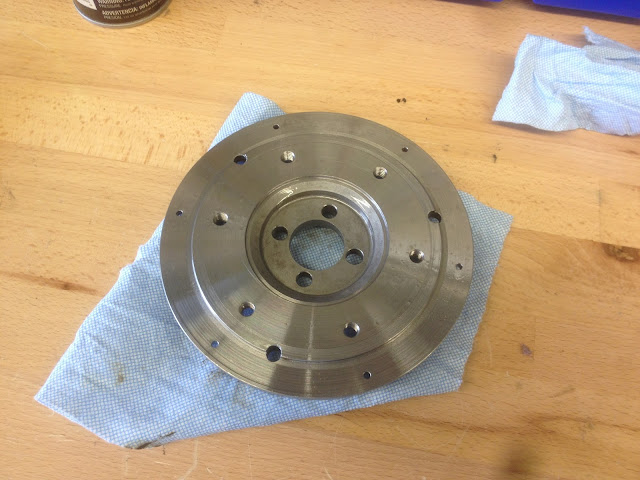That's version 2. Same dimensions, but machines a lot more like 4130 than the first one.
In this blurry picture I'm pointing out the locating step for the flexplate. That way I know it's concentric. I did the same on the inside for the prop extension:
Now that this is finished, I was able to start test assembling the crankcase. First, the connecting rods on the crankshaft:
Drop the crank assembly into the case and add some nuts, torqued to spec:
It still rotated freely after it was torqued, so that was a good sign. No rubbing or clearance issues so far. The next step was to add the head studs and check the piston deck height. I painted my head studs to help avoid corrosion:
And then I added them to the pile.
I added a cylinder and piston, and started taking measurements. I used a .030" shim under the cylinder, which is how the engine came to me. I set up my dial indicator and rotated the crank to TDC for that cylinder.
Zero'd up the dial indicator (though the photo makes it look off);
Using a piece of steel rod I had laying around as a straightedge, I measure deck clearance + rod width at 0.428" or so.
The rod I used measured 0.314", which means my clearance distance is 0.114". That's a lot more than I want! VW specs are between 0.040" and 0.080". I went back and checked, and the old pistons are the same as the new ones, and the old cylinders were within a couple thousandths of the new ones. That means that this engine was assembled wildly out of spec.... which shouldn't be a surprise, but it was. And means more work; removing the shims brings me down to 0.084", which is out of spec (and 0.024" more than I really want.) That means I'll have to chuck each cylinder up on the lathe and turn it down to what I want.
Unless...
...unless the heads are also anomalies, and have a much smaller chamber than normal heads, in which case the cylinders need to be extra long.... Bottom line, the new priority is get the heads reconditioned and blueprinted so I know what kind of setup I need.
There has been nothing straightforward about this engine. Armed with the knowledge I've gained from this process, I believe the next engine I assemble will be from brand new parts that I know the details on.










No comments:
Post a Comment